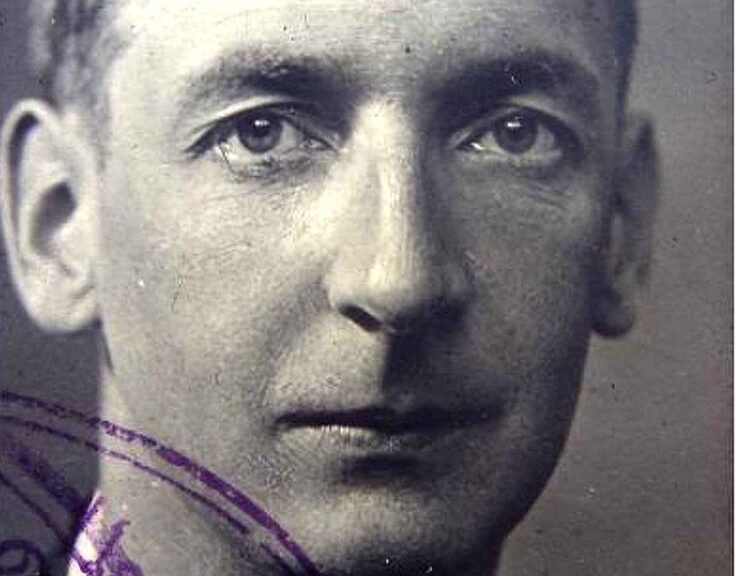LASZLO ALMASY (ne László Adolf Ede György Mária Almásy de Zsadány Törökszentmiklós} died on this date (b: 8/22/1895) was a Hungarian aristocrat, motorist, desert explorer, aviator, Scout-leader, and sportsman who served as the fictionalized basis for the protagonist in both Michael Ondaatje’s novel The English Patient (1992) and the movie adaptation of the same name (1996).
Almásy was born in Borostyánkő, Austria-Hungary (Bernstein im Burgenland, Austria), into a famous Hungarian noble family (his father was zoologist and ethnographer György Almásy), and, from 1911 to 1914, was educated at Berrow School, situated in a private house in Eastbourne, England, where he was tutored by Daniel Wheeler.
During World War I, Almásy joined the 11th Hussars along with his brother János. Almásy saw action against the Serbs, and then the Russians on the Eastern Front. In 1916, he transferred to the Austro-Hungarian Imperial and Royal Aviation Troops. After being shot down over Northern Italy in March 1918, Almásy served the remainder of the war as a flight instructor.
After the war, Almásy returned to join the Eastbourne Technical Institute, in East Sussex, England. From November 1921 to June 1922, he lodged at the same address in Eastbourne. He was a member of the pioneering Eastbourne Flying Club.
Returning to Hungary, the well-connected Almásy became the personal secretary of the Bishop of Szombathely, János Mikes, one of the leading figures of the abortive post-war Habsburg restoration attempt. The young Almásy became involved in these events by accident as the driver of Bishop Mikes when King Karl IV of Hungary returned to Hungary in 1921 to claim the throne, and was helped by Mikes to reach Budapest (from where he was politely but firmly sent back to Austria by Miklós Horthy, the Regent of Hungary). After he was introduced, the King continued to refer to him as Count Almásy, confusing László with another branch of the family. This was the basis for Almásy using the title to his advantage, mostly in Egypt among the Egyptian royalty to open doors that would have remained closed to a commoner. However, he himself admitted in private conversations that the title was not legitimate.
After 1921, Almásy worked as a representative of the Austrian car firm Steyr Automobile in Szombathely, Hungary, and won many car races in the Steyr colours. He managed to persuade a wealthy friend, Prince Antal Eszterházy, to join him in driving a Steyr from Alexandria to Khartoum, before embarking on a hunting expedition to the Dinder River, a feat which had never before been accomplished by an ordinary automobile.
From the beginnings of Boy Scouting in 1908, Almásy was a member of the movement. In 1921 Almásy became the International Commissioner of the Hungarian Scout Association. With Count Pál Teleki, he took part in organizing the 4th World Scout Jamboree in Jamboree in Gödöllő, Hungary, where Almásy presented the Air Scouts to Robert Baden-Powell in August 1933.
After the outbreak of World War II in 1939, Almásy had to return to Hungary. The British suspected that he was a spy for the Italians, and vice versa. While there is no evidence to suggest that he was involved in any clandestine intelligence gathering prior to the war, he was clearly not welcomed by authorities on either side of the Egypt-Libya border. Hungary formally joined the Axis powers by signing the Tripartite Pact in November 1940. Almásy joined the Royal Hungarian Air Force (RHAF). In February 1941 he, as a Hungarian officer was commanded to the Abwehr, to the Afrika Corps.
Almásy’s greatest achievement during his wartime stay in North Africa was the successful completion of Operation Salam, the infiltration of two German spies through the Libyan Desert behind enemy lines in a manner similar to the Allied Long Range Desert Group. Operation Salam was not a covert operation; Almásy and his team were wearing German uniforms. They used captured British (Canadian-built) Ford cars and trucks with German crosses surreptitiously incorporated into the vehicles’ camouflage pattern. Almásy successfully delivered the two Abwehr agents, Johannes Eppler and his radio operator Hans-Gerd Sandstede, to Assiut in Egypt after crossing the Gilf Kebir and Kharga Oasis.
Unknown to Almásy and the German command, British code breakers at Bletchley Park had broken the Abwehr hand cypher that Almásy and the spies used for their wireless transmissions. A young intelligence analyst at Bletchley Park, Jean Alington (later Jean Howard), noticed the signal trail. However, as the warning to the British HQ ME in Cairo arrived too late (due to the imminent attack of Rommel), Afrika Korps messages had a higher priority for deciphering and analysis, and Almásy was able to return to his starting point at Gialo unhindered.
Eppler and subsequent mission, Operation Condor, was a complete failure; they were both captured within six weeks of reaching Cairo. Almásy received both the 1st and 2nd Class of the Iron Cross (Eisernes Kreuz) and a promotion to Major for the success of Operation Salam. However, his services in North Africa were no longer needed, and he returned to Hungary, where he wrote a short book on his wartime experiences in Libya.
Fans of Fiennes’ handsome Almásy in The English Patient might be unhappy to find that the real guy is described in his British intelligence MI5 file as “ugly and shabbily dressed, with a fat and pendulous nose, drooping shoulders and a nervous tic”. It also turns out that he helped the Nazis in World War II, and then, apparently, spied for the USSR. For his daring on the side of the Nazis, he was awarded the German Iron Cross by the charming Erwin Rommel.
